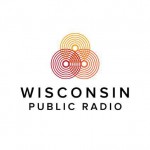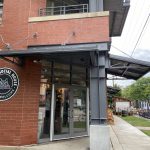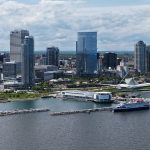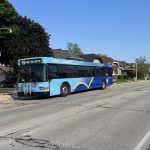Green Bay Replaces Every Lead Pipe
Five-year effort replaces more than 2,000 pipes. Lambeau Field tax helped pay for it.

Crews replace a lead service line on Emilie Street in Green Bay, Wis, on Tuesday, Oct. 6, 2020. It was the last one in the city, officials said. Megan Hart/WPR
Green Bay officials gathered Tuesday on Emilie Street to celebrate the completion of the city’s five-year effort to remove more than 2,000 lead pipes.
The multimillion-dollar work wrapped up at the home of Deb Weaver, who moved to Green Bay six years ago. The fact that officials had the foresight to invest in replacing the city’s lead pipes shows why it’s a great place to live, she said.
“We have access to city amenities, yet it feels like a small town, and in small towns people genuinely care about one another,” she said.
“It’s really a great example of what we can do when we identify a problem, but also allocate the resources that are necessary to really address it,” said Green Bay Mayor Eric Genrich, who grew up on Emilie Street.
Nancy Quirk, general manager of Green Bay Water Utility, said the journey began years ago when tests showed the water in some homes was contaminated with lead.
“Instead of making excuses or kicking the can down the road, our utility chose to quite literally dig deeper to get to where we are today,” she said.
Around the time the water crisis in Flint, Michigan, made national headlines, Green Bay Water Utility committed to removing all lead service lines by the end of 2020.
Quirk said the project encompassed three parts: find the lead pipes, replace them and pay for it.
Green Bay Water Utility began by immediately replacing utility-owned lead service lines while deploying meter readers to see whether homeowners might have lead pipes, she said.
The utility worked with the city’s Department of Public Works to replace water mains at the same time crews repaved roads, making it cheaper. They worked through rain, heat, sleet and snow, she said.
“I am so happy and proud today of what this utility has accomplished,” she said.
Financing the work was a collaborative effort. Rates increases, Safe Drinking Water Loans from the state Department of Natural Resources and funds from the Lambeau Field tax — originally established to help pay for renovations at the stadium — all contributed, Quirk said.
David Ross, assistant administrator at the EPA, said he’ll share Green Bay as a model as other cities address their lead service lines.
Green Bay joins Madison in having retired all its lead service lines. Milwaukee has more than 70,000 lead lines, but officials have said funding is a barrier to replacing them.
Lead exposure can cause health problems, especially in children.
Listen to the WPR report here.
Green Bay Has Officially Replaced All City’s Lead Pipes was originally published by Wisconsin Public Radio.
More about the Lead Crisis
- MPS’s Westside Academy Cleared of Lead Risks After Stabilization Work - Milwaukee Public Schools - Jul 1st, 2025
- MPS Plans Lead Remediation at 40 Schools This Summer - Evan Casey - Jun 27th, 2025
- Baldwin, Reed Demand Written Answers from RFK, Jr. on Firings of Childhood Lead Poisoning Experts at CDC - U.S. Sen. Tammy Baldwin - Jun 11th, 2025
- MPS’s LaFollette School Cleared of Lead Risks After Stabilization Work - Milwaukee Public Schools - Jun 11th, 2025
- Sen. Baldwin Hears From Parents About MPS Lead Crisis, Chides RFK Jr. - Evan Casey - Jun 9th, 2025
- Reps. Margaret Arney and Darrin Madison Urge Joint Finance Committee to Reinstate Essential Lead Abatement Funding - State Rep. Margaret Arney - Jun 5th, 2025
- Gov. Evers, DHS Continue Administration’s Efforts to Combat Lead Poisoning Statewide with Permanent Rule - Gov. Tony Evers - May 27th, 2025
- RFK Jr. Claims ‘Team’ Is In Milwaukee Helping With Lead Crisis, Health Department Can’t Find Them - Nick Rommel - May 22nd, 2025
- MPS Announces Starms Early Childhood Center Is Cleared of Lead Dangers - Milwaukee Public Schools - May 21st, 2025
- Milwaukee Has Removed 10,000 Lead Laterals - Graham Kilmer - May 13th, 2025
Read more about Lead Crisis here



















